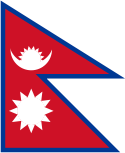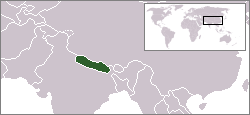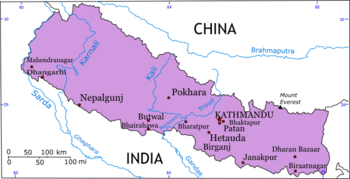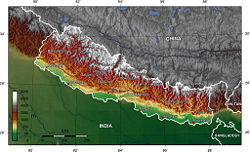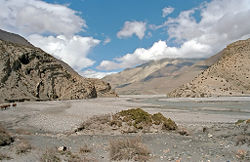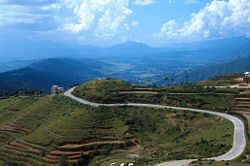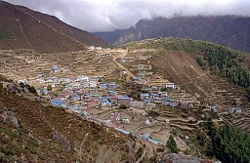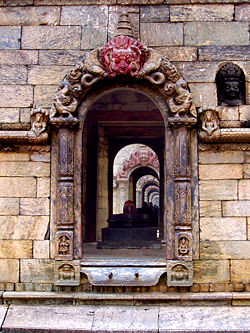Nepal
| नेपाल Nepāl | |||||
| |||||
| Motto: जननी जन्मभूमिष्च स्वर्गादपि गरीयसी (Sanskrit) "Mother and motherland are dearer than the heavens" | |||||
| Anthem: Rastriya Gaan | |||||
| Capital (and largest city) |
Kathmandu 27°42′N 85°19′E | ||||
| Official languages | Nepali | ||||
|---|---|---|---|---|---|
| Government | interim constitutional arrangements | ||||
| - King | King Gyanendra Bir Bikram Shah[1] | ||||
| - Interim Head of State | Girija Prasad Koirala | ||||
| - Prime Minister | Girija Prasad Koirala | ||||
| Unification | December 21 1768 | ||||
| Area | |||||
| - Total | 147,181 km² (93rd) 56,827 sq mi | ||||
| - Water (%) | 2.8 | ||||
| Population | |||||
| - July 2005 estimate | 27,133,000 | ||||
| - 2002 census | 23,151,423 | ||||
| - Density | 184/km² 477/sq mi | ||||
| GDP (PPP) | 2005 estimate | ||||
| - Total | $39.14 billion | ||||
| - Per capita | $1,675 | ||||
| HDI (2003) | 0.526 (medium) | ||||
| Currency | Rupee (NPR)
| ||||
| Time zone | NPT (UTC+5:45) | ||||
| - Summer (DST) | not observed (UTC+5:45) | ||||
| Internet TLD | .np | ||||
| Calling code | +977 | ||||
Nepal, officially known as the State of Nepal (Nepali: नेपाल [neˈpaːl] )a landlocked Himalayan country in South Asia, is a kingdom of various geographical features, and is culturally rich.
For a small territory, the Nepali landscape is uncommonly diverse, ranging from the humid Terai in the south to the lofty Himalayas in the north. Nepal boasts eight of the world's 14 highest mountains, including Mount Everest on the border with China.
The political scene in Nepal is one of the most confusing in the world. In the past 10 years, Nepal has sustained a Maoist insurgency, the heir-apparent murdered the royal family, and the new king dismissed and re-instated parliament.
More than 80 percent of Nepalese follow Hinduism, which is higher than the percentage of Hindus in India, making it the single most Hindu nation in the world.
Geography
The origin of the name Nepal is uncertain, but the most popular understanding is that it derived from Ne (holy) and pal (cave).
Bordered by China (Tibet) to the north and by India to the south, east and west, Nepal is of roughly trapezoidal shape, 500 miles (800 kilometers) long and 125miles (200 kilometers) wide, with an area of 56,827 square miles (147,181 square kilometres), or slightly larger than the United States state of Arkansas.
Although Nepal shares no boundary with Bangladesh, the two countries are separated by a narrow strip of land about 13 miles wide (21 kilometers), called the Chicken's Neck. Efforts are underway to make this area a free-trade zone.
The Himalayan arc extends about 1491 miles (2400 km) from Nanga Parbat (26,699 feet or 8138 metres), the second highest peak in Pakistan, in the west, to Namche Barwa (25,149 feet or 7756 metres) in Tibet, in the east. This region includes Nepal, Bhutan, and as well as parts of Pakistan, India, and China. The process of forming the Himalayas began with the collision of Indian sub-continent and Eurasia at the Paleocene/Eocence epoch. This thickened the Indian crust to its present thickness of 41 miles or 70 kilometers.
Nepal is commonly divided into three physiographic areas: the mountain, hill, and Terai regions. These ecological belts run east-west and are bisected by Nepal's major river systems. The lowest point is Kanchan Kalan, at 229 feet (70 meters) above sea level. The highest point is (Sagarmatha) Mount Everest at 29,028 feet (8848 meters).

The mountain region is the highest in the world. Mount Everest is located on the border with China between Nepal and Tibet. The south-east ridge on the Nepalese side of the mountain is easier to climb, which is why so many climbers are pouring in through Nepal. Eight of the world's highest mountains are located in Nepal. Kanchenjunga, the world's third highest peak, is also located in Nepal. Other mountains including Annapurna I, II, III and IV are located in the Annapurna Mountain Range in Nepal.
The hill region (Pahad in Nepali) abuts the mountains and varies from 3300 to13,125 feet (1000 to 4000 meters) in altitude. Two low mountain ranges, the Mahabharat Lekh and Siwalik Hills (also called the Churia Range) dominate the region. The hilly belt includes the Kathmandu Valley, the country's most fertile and urbanised area. Despite its geographical isolation and limited economic potential, the region always has been the political and cultural centre of Nepal. Elevations above 8200 feet (2500 meters) are sparsely populated.
The Terai Plains bordering India are part of the northern rim of the Indo-Gangetic plains. They were formed and are fed by three major rivers: the Kosi, the Narayani (India's Gandak River), and the Karnali. This region has a hot, humid climate.
Nepal has five climatic zones, broadly corresponding to altitude. The tropical and subtropical zones lie below 3940 feet (1200 metres), the temperate zone 3900 to 7875 feet (1200 to 2400 metres), the cold zone 7875 to 11,800 feet (2400 to 3600 metres), the sub-arctic zone 11,800 to 14,400 feet (3600 to 4400 metres), and the arctic zone above 14,400 feet (4400 metres). Nepal has five seasons: summer, monsoon, autumn, winter and spring. The Himalaya blocks cold winds from Central Asia in winter, and forms the northern limit of the monsoon wind patterns.
About 25.4 percent of Nepal is covered with forest, of which around 9.6 percent consists of "primary forest" which is relatively intact. About 12.1 percent is classified as "protected," about 21.4 percent is "conserved," and about 5.1 percent are classified as "production forest." Nepal's 2000-2005 deforestation rate was about 1.4 percent per year.
Nepal has three major river systems from east to west: the Koshi River basin, the Narayani River basin (India's Gandak River), and the Karnali River basin. All ultimately become major tributaries of the Ganges River in northern India. After plunging through deep gorges, these rivers deposit their heavy sediments and debris on the plains. Besides providing fertile alluvial soil, the backbone of the agrarian economy, these rivers present great possibilities for hydroelectric and irrigation development. Building dams in Nepal has remained a disputed issue, mainly because of the high risk of earthquakes. Deep gorges posed immense obstacles to establishing transport and communication networks. As a result, the economy in Nepal has remained fragmented.
Natural hazards include severe thunderstorms, flooding, landslides, drought, and famine depending on the timing, intensity, and duration of the summer monsoons.
Environmental issues include deforestation (overuse of wood for fuel and lack of alternatives), with resulting erosion and degradation of ecosystems, contaminated water (with human and animal wastes, agricultural run-off, and industrial effluents), wildlife conservation, and vehicular emissions.
Kathmandu is the capital and largest city. The other main cities include Bharatpur, Biratnagar, Bhairahawa, Birgunj, Janakpur, Pokhara, Nepalgunj, and Mahendranagar.
History
Neolithic tools found in the Kathmandu Valley indicate that people have been living in the Himalayan region for at least 9000 years. Documented references reach back to the first millennium B.C.E., when ancient Indian epics such as the Mahabharata mention the Kiratas, the inhabitants of Nepal. It appears that people who were probably of Tibeto-Burman ethnicity lived in Nepal 2500 years ago. Ramayana, which refers to the era before Mahabharat, states Mithila, which is currently known as Janakpur in Nepal, as the birth place of goddess Sita. Also, the presence of historical sites, such as, Valmik ashram, indicates the presence of Aryan culture in Nepal at that period
Indo-Aryan tribes entered the valley around 1500 B.C.E.
Around 1000 B.C.E., small kingdoms and confederations of clans arose. One of the princes of the Shakya confederation was Siddhartha Gautama (563–483 B.C.E.), who renounced his royalty to lead an ascetic life and came to be known as the Buddha ("the one who has awakened").
By 250 B.C.E., the region came under the influence of the Mauryan empire of northern India, and later became a puppet state under the Gupta Dynasty in the fourth century.
From the late fifth century, rulers called the Licchavis governed the area. The Licchavi dynasty went into decline in the late eighth century and was followed by a Newar era, from 879, although the extent of their control over the entire country is uncertain.
By late 11th century, southern Nepal came under the influence of the Chalukya Empire of southern India. Under the Chalukyas, Nepal's religious establishment changed as the kings patronised Hinduism instead of the Buddhism prevailing at that time.
By the early thirteenth century, leaders were emerging whose names ended with the Sanskrit suffix malla ("wrestler"). Arimalla was the first king of this dynasty, which was initially marked by upheaval before the kings consolidated their power over the next 200 years.
Thirteenth-century Nepal was occasionally pillaged by the Delhi Sultanate of northern India, and was marked by increased militarisation. By the late fourteenth century king Jayasthitimalla managed to unite most of the country. This unity was short-lived: in 1482 the kingdom was carved into three: Kathmandu, Patan, and Bhadgaon.
Modern Nepal was created in the latter half of the eighteenth century when Prithvi Narayan Shah, the ruler of the small principality of Gorkha, formed a unified country from a number of independent hill states. The country was frequently called the Gorkha Kingdom.
Prithvi Narayan Shah conquered the Kathmandu valley and created a single in 1768. Between 1717 and 1733, the Nepalese in the west and Bhutanese in the east attacked Sikkim many times, culminating with the destruction of the capital Rabdentse by the Nepalese. The Sikkim king fled to Tibet. After Shah's death, the Shah dynasty began to expand their kingdom into India. Between 1788 and 1791, Nepal invaded Tibet and robbed Tashilhunpo Monastery of Shigatse. Alarmed, the Chinese emperor Qianlong dispatched a sizeable army that forced the Nepalese to retreat and pay heavy repatriations.
After 1800, the heirs of Prithvi Narayan Shah proved unable to maintain firm political control over Nepal. A period of internal turmoil followed.
Rivalry with the British East India Company over the annexation of minor states bordering Nepal eventually led to the brief but bloody Anglo-Nepalese War (1815–16), in which Nepal defended its present day borders but lost its territories west of the Kali River, including present day Uttarakhand state and several Punjab Hill States of present day Himachal Pradesh. The Treaty of Sugauli also ceded parts of the Terai and Sikkim to the company in exchange for Nepalese autonomy.
Factionalism among royal family members led to instability after the war. In 1846, a discovered plot to overthrow Jang Bahadur, a fast-rising military leader by the reigning queen, led to the Kot Massacre. Armed clashes between military personnel and administrators loyal to the queen led to the execution of several hundred princes and chieftains around the country. Bahadur won and founded the Rana dynasty, leading to the Rana autocracy. The king was made a titular figure, and the post of Prime Minister was made powerful and hereditary.
The Ranas were staunchly pro-British, and assisted the British during the Sepoy Rebellion in 1857, and later in both World Wars. In 1923 the United Kingdom and Nepal formally signed an agreement of friendship, in which Nepal's independence was recognised by the UK.
In the late 1940s, emerging pro-democracy movements and political parties in Nepal were critical of the Rana autocracy. China occupied Tibet in 1950, making India keen on stability in Nepal, to avoid an expansive military campaign. Thus India sponsored Tribhuvan as Nepal's new king in 1951, and a new government, mostly comprising the Nepali Congress Party.
In early 1959, King Mahendra issued a new constitution, and the first democratic elections for a national assembly were held. The Nepali Congress Party, a moderate socialist group, gained a substantial victory in the election. Its leader, B.P. Koirala, formed a government and served as prime minister.
Declaring parliamentary democracy a failure 18 months later, King Mahendra dismissed the Koirala government and promulgated a new constitution on December 16, 1962. The new constitution established a "partyless" system of panchayats (councils) which King Mahendra considered to be a democratic form of government closer to Nepalese traditions. As a pyramidal structure progressing from village assemblies to a Rastriya Panchayat (National Parliament), the panchayat system enshrined the absolute power of the monarchy.
King Mahendra was succeeded by his 27 year-old son, King Birendra , in 1972. Amid student demonstrations and anti-regime activities in 1979, King Birendra called for a national referendum to decide on the nature of Nepal's government—either the continuation of the panchayat system with democratic reforms or the establishment of a multiparty system. The referendum was held in May 1980, and the panchayat system won a narrow victory.
In 1989, the "Jan Andolan" (People's) Movement forced the monarchy to accept constitutional reforms and establish a multiparty parliament in May 1991. The Nepali Congress Party won the country's first democratic elections, with Girija Prasad Koirala becoming prime minister.
In 1992, in a situation of economic crisis and chaos, with spiralling prices as a result of implementation of changes in policy of the new Congress government, the radical left stepped up their political agitation. The various groups set up a Joint People's Agitation Committee, and called for a general strike on April 6.
Violence broke out on the evening of the strike. Two activists were killed early the next day. Later in the day, police fired on a mass rally of the Agitation Committee at Tundikhel in the capital Kathmandu. Riots broke out, leaving 14 dead.
In February 1996, a Maoist party started a bid to replace the parliamentary monarchy with a so-called people's new democratic republic, through a Maoist revolutionary strategy known as the people's war, which has led to the Nepalese Civil War. Led by Dr Baburam Bhattarai and Pushpa Kamal Dahal (also known as "Prachanda"), the insurgency began in five districts in Nepal. The Maoists declared the existence of a provisional "people's government" at the district level in several locations. At one point, 70 percent of Nepal's countryside was under Maoist rule. More than 13,000 people died in the civil war.
In June 2001 Crown Prince Dipendra went on a shooting-spree assassinating 11 members of the royal family including King Birendra and Queen Aishwarya before shooting himself. He temporarily became king before dying of his wounds resulting in his brother, Prince Gyanendra, inheriting the throne. Meanwhile, the Maoist rebellion escalated, and in October 2002 the king temporarily deposed the government and took complete control of it. A week later he reappointed another government, but the country is still unstable because of the civil war with the Maoists, the various political factions, the king's attempts to take more control of the government and worries about the competence of Gyanendra's son and heir, Prince Paras.
In the face of unstable governments and a Maoist siege on the Kathmandu Valley in August 2004, popular support for the monarchy began to wane. On February 1, 2005, Gyanendra dismissed the entire government and assumed full executive powers, declaring a "state of emergency" to quash the Maoist movement.
In April 2006, strikes and street protests in Kathmandu forced the king to reinstate the parliament. A seven-party coalition resumed control of the government and stripped the king of most of his powers. A cease fire was agreed to, on November 21, 2006, with the Maoist parties. As of January 15, 2007, Nepal was governed by a unicameral legislature under an interim constitution.
Economy
Agriculture sustains 76% of the population and accounts for about 39% of the GDP; services comprise 42%, and industry 21%. Hilly and mountainous terrain in the northern two-thirds of the country has made the building of roads and other infrastructure difficult and expensive. There were just over 8,500 km of paved roads, and one 59 km railway line in the south in 2003. Aviation is in a better state, with 48 airports, ten of them with paved runways. There is less than one telephone per 19 people; landline services are not adequate nationwide but concentrated in cities and district headquarters; mobile telephony is in a reasonable state in most parts of the country with increased accessibility and affordability. There were around 175,000 Internet connections in 2005, but after the imposition of the "state of emergency", intermittent losses of service were reported. Uninterrupted internet connections have resumed after the brief period of confusion as Nepal's second major people's revolution took place to overthrow the King's absolute power.[2]
Its landlocked location (actually landlinked, since Nepal is not locked) and [3] technological backwardness and the long-running civil war have also prevented Nepal from fully developing its economy. The country receives foreign aid from India, Japan, United Kingdom, United States, European Union, China, Switzerland, and Scandinavian Countries. The government's budget is about US$1.153 billion, with expenditures of $1.789bn (FY05/06). The inflation rate has dropped to 2.9% after a period of higher inflation during the 1990s. The Nepalese Rupee has been tied to the Indian Rupee at an exchange rate of 1.6 for many years. Since the loosening of exchange rate controls in the early 1990s, the black market for foreign exchange has all but disappeared. A long-standing economic agreement underpins a close relationship with India.
The distribution of wealth among people is consistent with that in many developed and developing countries: the highest 10% of households control 39.1% of the national wealth and the lowest 10% control only 2.6%.
Nepal's workforce of about 10 million suffers from a severe shortage of skilled labour. Agriculture employs 81% of the workforce, services 16% and manufacturing/craft-based industry 3%. Agricultural produce——mostly grown in the Terrai region bordering India——includes rice, corn, wheat, sugarcane, root crops, milk, and water buffalo meat. Industry mainly involves the processing of agricultural produce, including jute, sugarcane, tobacco, and grain. The spectacular landscape and deep, exotic culture of Nepal represents considerable potential for tourism, but growth in this export industry has been stifled by recent political events. The rate of unemployment and underemployment approaches half of the working-age population. Thus many Nepalese move to India in search of work, the Gulf countries and Malaysia being new sources of work. Poverty is acute.[4] Nepal receives US$50 million a year through the Gurkha soldiers who serve in the Indian and British armies and are highly esteemed for their skill and bravery. The total remittance value is worth around 1 billion USD, including money sent from Persian Gulf and Malaysia, who combined employ around 700,000 Nepalese.
Nepal's GDP for the year 2005 is estimated at just over US$39 billion (adjusted to Purchasing Power Parity), making it the 83rd-largest economy in the world. Per-capita income is around US$1,402, ranked 163rd. Nepal's exports of mainly carpets, clothing, leather goods, jute goods and grain total $822 million. Import commodities of mainly gold, machinery and equipment, petroleum products and fertilizer total US$2 bn. India (53.7%), the US (17.4%), and Germany (7.1%) are its main export partners. Nepal's import partners include India (47.5%), the United Arab Emirates (11.2%), China (10.7%), Saudi Arabia (4.9%), and Singapore (4%).
Government and politics
Until 1990, Nepal was an absolute monarchy running under the executive control of the king. Faced with a people's movement against the absolute monarchy, King Birendra, in 1990, agreed to large-scale political reforms by creating a parliamentary monarchy with the king as the head of state and a prime minister as the head of the government.
Nepal's legislature was bicameral consisting of a House of Representatives and a National Council. The House of Representatives consists of 205 members directly elected by the people. The National Council had 60 members, 10 nominated by the king, 35 elected by the House of Representatives and the remaining 15 elected by an electoral college made up of chairs of villages and towns. The legislature had a five-year term, but was dissolvable by the king before its term could end. All Nepalese citizens 18 years and older became eligible to vote.
The executive comprised the King and the Council of Ministers (the Cabinet). The leader of the coalition or party securing the maximum seats in an election was appointed as the Prime Minister. The Cabinet was appointed by the king on the recommendation of the Prime Minister. Governments in Nepal have tended to be highly unstable; no government has survived for more than two years since 1991, either through internal collapse or parliamentary dissolution by the monarch.
The April movement of 2006 brought about a change in the nation. The autocratic King had to give up power. The dissolved House of Representatives was restored. The House of Representatives formed a government which had successful peace talks with the Maoist Rebels. An interim constitution was promulgated and an interim House of Representatives was formed with Maoist members. The number of seats were also increased to 330.
Military and foreign affairs
Nepal's military consists of the Nepalese Army which includes the Nepalese Army Air Service, (the air force unit under it), and the Nepalese Police Force. On May 19, 2006 The House unanimously passed the proposal to rename Royal Nepal Army (RNA) as the “Nepali Army”. Service is voluntary and the minimum age for enlistment is 18 years. Nepal spends $99.2 million (2004) on its military—1.5% of its GDP. The Nepali Army has 90,000 soldiers, who were engaged in the civil war against the Maoist insurgents. [5]
Nepal has close ties with both of its neighbours, India and China. In accordance with a long-standing treaty, Indian and Nepalese citizens may travel to each others' countries without a passport or visa. Nepalese citizens may work in India without legal restriction. Although Nepal and India typically have close ties, from time to time Nepal becomes caught up in the problematic Sino-Indian relationship. India considers Nepal as part of its realm of influence, and views Chinese aid with concern. Some Indians consider Nepal to be part of a greater pan-Indian state, an attitude that has caused Nepalese antagonism towards India. Moreover, there is a growing anti-Indian sentiment among some Nepali youths.[citation needed] In 2005, after King Gyanendra took over, Nepalese relations with India, the U.S., and the UK have worsened. These three foreign countries have been vociferous opponents to the crackdown on civil liberties in Nepal. China mainly seeks cooperation with Nepal on the issue of Tibetan independence, including the degree of freedom that Nepal gives the thousands of Tibetan refugees living in its territory and the approximately 2,000-3,000 Tibetans that seek to escape Tibet through Nepal each year. Outside of Asia, Nepal has especially friendly relations with Germany, Japan [6] and has historical military links with the United Kingdom.
Administrative divisions
Nepal is divided into 14 zones and 75 districts grouped into five development regions. Each district is headed by a fixed chief district officer responsible for maintaining law and order and coordinating the work of field agencies of the various government ministries.
| The 14 zones are: | ||
| 1 Bagmati | 8 Lumbini | |
| 2 Bheri | 9 Mahakali | |
| 3 Dhawalagiri | 10 Mechi | |
| 4 Gandaki | 11 Narayani | |
| 5 Janakpur | 12 Rapti | |
| 6 Karnali | 13 Sagarmatha | |
| 7 Koshi | 14 Seti | |
Demographics
Nepal has a total population of 27,676,547 as of July 2005, with a growth rate of 2.2%. 39% of the population is up to 14 years old, 57.3% are aged between 15 and 64, and 3.7% above 65. The median age is 20.07 (19.91 for males and 20.24 for females). There are 1,060 males for every 1,000 females. Life expectancy is 59.8 years (60.9 for males and 59.5 for females). Nepal is the only country in the world where males outlive females. Total literacy rate is 53.74% (68.51% for males and 42.49% for females).
According to the 2001 census, Hindus constitute 80.6% of the population. Buddhists make up 10.7%, Muslims 4.2%, Kirant 3.6%, other religions 0.9%. The largest ethnic group is the Chhettri (15.5%). Other groups are the Brahman-Hill 12.5%, Magar 7%, Tharu 6.6%, Tamang 5.5%, Newar 5.4%, Kami 3.9%, Yadav 3.9%, other 32.7%, unspecified 2.8%. Nepali is the national language with 47.8% of the population speaking it as their first language. Other languages include Maithili 12.1%, Bhojpuri 7.4%, Tharu (Dagaura/Rana) 5.8%, Tamang 5.1%, Nepal Bhasa 3.6%, Magar 3.3%, Awadhi 2.4%, other 10%, unspecified 2.5%. Differences between Hindus and Buddhists have been in general very subtle and academic in nature due to the intermingling of Hindu and Buddhist beliefs. Both share common temples and worship common deities and many of Nepal's Hindus could also be regarded as Buddhists and vice versa. Buddhists are mostly concentrated in the eastern regions and the central Terrai. Buddhism was relatively more common among the Newar and Tibeto-Nepalese groups. Among the Tibeto-Nepalese, those most influenced by Hinduism were the Magar, Sunwar, Limbu and Rai. Hindu influence is less prominent among the Gurung, Bhutia, and Thakali groups, who employ Buddhist monks for their religious ceremonies.[2] [7]
The northern mountains are sparsely populated. A majority of the population live in the central highlands despite the migration of a significant section of the population to the fertile Terrai belt in recent years. Kathmandu, with a population of 800,000, is the largest city in the country.
Culture
Nepali culture is influenced by the cultures of Tibet, and India, which borders to the south. There are similarities in clothing, language and food. A typical Nepali meal is dal-bhat - boiled dal served with rice and vegetables, and some spicy relish. This is consumed twice daily, once in the morning and again after sunset. Between these main meals, snacks such as chiura (beaten rice) and tea are consumed. Apart meat, eggs, and fish are considered a treat. In the mountainous region the staple diet are based on wheat, maize, millet and potatoes. Millet-based alcoholic drinks known as "Tongba" and other cereal based alcohol are popular, including chhaang and the distilled rakshi. However, the Newar community enjoys its own special Newari cuisine.
Traditional Nepali folklore retains a strong influence in society and its stories are widely acted out in dance and music. Culture of different ethenic groups are rich in their own ways. However, Newari culture is the most common culture in the capital city. Most of the festivals observed in the country are the Newari festivals. The Newar people are well known for masked dance that tell stories of the gods and heroes. The associated music is percussion-based, sometimes with flutes or shawm accompanying the intense, nasal vocal lines. Musical styles are a variety of pop, religious and folk music, among other styles. Musical genres from Tibet and India have had a strong influence on traditional Nepali music. Women, even of the musician castes, are less likely than men to play music, except in specific situations such as traditional all-female wedding parties.
The sarangi, a four-stringed, hand-carved instrument is usually played by wandering minstrels. Since the sixties, Nepali rock or rock music, sung to Nepali lyrics, has become popular among youth. Also catching on fast is Nepali rap and Nepali reggae which has blossomed with the advent of the music video industry. There are also many heavy metal bands. Football is the most popular sport, followed by cricket and kabaddi. The Martyrs Memorial Football League is the national football championship.
Television was only introduced to Nepal in the 1980s. Currently there are six television broadcasting channels: Nepal Television - the national television channel; NTV 2 Metro - a city channel owned by the government; and four private channels - Kantipur Television, Image Channel, Channel Nepal & Nepal 1. Also many other networks, particularly those that originate in India, are available with the installation of increasingly popular satellite dishes, although lack of electrification makes this difficult. Radio is listened to throughout the kingdom; as of 2000, there were 12 radio stations.
The Nepali year begins in mid-April and is divided into 12 months. Saturday is the official weekly day of rest. Main holidays include the National Day (birthday of the late king Tribhuvan) December 28, Prithvi Jayanti, (January 11), and Martyr's Day (February 18) and a mix of Hindu and Buddhist festivals[8] such as Teej, Dashai in autumn, and Tihar late autumn. Most marriages are arranged, and divorce is rare. Polygamy is banned by law; relatively isolated tribes in the north, such as the Dolpo, practise polyandry. Nepal has a rich tradition of ceremonies, such as nwaran (the christening of a child), and the Pasni, the day a child is first fed rice, and bratabandha (the penance ceremony) and gupha for prepubescent boys and girls, respectively. In Newari culture,bel bibaha, preadolescent girls are "married" to the bel fruit tree, ensuring that the girl becomes and remains fertile.
Most houses in rural Nepal are made up of a tight bamboo framework with mud and cow-dung walls. These dwellings remain cool in summers and retain warmth in the winter. Dwellings at higher altitudes are mostly timber-based.
Woman's status in Nepal has been steadily rising.
See also
Template:Nepal
Notes
- ↑ Currently, the King of Nepal has no officially constitutional role, as the role of head of state was transferred to the Prime Minister as an interim arrangement until the Constituent Assembly to be elected in June 2007 decides on the monarchy's fate.[1]
- ↑ 2.0 2.1 Nepal. CIA World Factbook. Retrieved September 23, 2005.
- ↑ Nepal: Economy. MSN Encarta. Retrieved September 23, 2005.
- ↑ Nepal. Factbook on Global Sexual Exploitation. Retrieved September 23, 2005.
- ↑ Srivastava, Siddharth, "India hits Nepal where it hurts", Asia Times Online, 2005-02-24. Retrieved 2005-09-23.
- ↑ http://www.auswaertiges-amt.de/diplo/de/Laenderinformationen/Nepal/Bilateral.html
- ↑ Cite error: Invalid
<ref>tag; no text was provided for refs namedLibrary_of_Congress - ↑ Nepal: Basic Fact Sheet. Nepal homepage. Retrieved September 23, 2005.
ReferencesISBN links support NWE through referral fees
- Nepal. MSN Encarta. Retrieved September 23, 2005.
- India Nepal Open Border. Nepal Democracy. Retrieved September 23, 2005.
- Football at the heart of the Himalaya. FIFA. Retrieved September 23, 2005.
- [2] The Best Memoir You Never Heard Of: "Shadow Over Shangri-La" Offers Compelling and Timely Story of Nepal (San Francisco Chronicle)].
- Etymology of the word "Nepal". Infoclub.com.np. Retrieved September 23, 2005.
- Nepal: A state under siege. The South Asian: Featured Articles. Retrieved September 23, 2005.
- Nepal: Basic Fact Sheet. Nepal homepage. Retrieved September 23, 2005.
- Jailed ex-PM in Nepal court plea. BBC News. Retrieved September 29, 2005.
- Gotz Hagmuller (2003). Patan Museum: The Transformation of a Royal Palace in Nepal. London: Serindia. ISBN 0-9-6-26-58-X.
- Kunda Dixit (2006). [A people war: Images of the Nepal conflict 1996-2006]. Kathmandu: nepa-laya. ISBN.
- Barbara Crossette (1995). So Close to Heaven: The Vanishing Buddhist Kingdoms of the Himalayas. New York: Vintage. ISBN 0-679-74363-4.
- Bista, Dor Bahadur (1967). People of Nepal. Dept. of Publicity, Ministry of Information and Broadcasting, Govt. of Nepal. ISBN 99933-0-418-2.
- Michael Hutt, ed., Himalayan 'people's war' : Nepal's Maoist rebellion, London : C. Hurst, 2004
- Peter Matthiessen (1993). The Snow Leopard. Penguin. ISBN 0-00-272025-6.
- Joe Simpson (1997). Storms of Silence. Mountaineers Books. ISBN 0-89886-512-3.
- Samrat Upadhyay (2001). Arresting God in Kathmandu. Mariner Books. ISBN 0-618-04371-3.
- Joseph R. Pietri (2001). The King of Nepal. Joseph R. Pietri. ISBN 0-615-11928-X.
- Maurice Herzog (1951). Annapurna. The Lyons Press. ISBN 1-55821-549-2.
- Dervla Murphy (1968). The Waiting Land: A Spell in Nepal. Transatlantic Arts. ISBN 0-7195-1745-1.
- Rishikesh Shaha (2001). Modern Nepal: A Political History. Manohar Publishers and Distributors. ISBN 81-7304-403-1.
External links
- Nepali Times weekly
- Euro Nepal Communication - France Népal
- Nepal Tourism Board
- A people war: Images of the Nepal conflict 1996-2006
- Government of Nepal
- Encyclopaedia Britannica Nepal Country Page
- United States Department of State Profile of Nepal
- Library of Congress — Nepal
- Planet Nepal Wiki
- Open Directory Project — Nepal
- Travel guide to Nepal from Wikitravel
- MyHimalayas — Travelogues and Pictures from various areas in Nepal
- Images and Photos from different parts of Nepal
- IPS Inter Press Service Independent news reports and features about the "Crisis in the Himalayas"
- Nepal information Nepal Geography, Climate, Population, how to get in and other useful information.
Bangladesh · Bhutan · India · Maldives · Nepal · Pakistan · Sri Lanka
Sometimes included: Afghanistan • Iran • Myanmar
Credits
New World Encyclopedia writers and editors rewrote and completed the Wikipedia article in accordance with New World Encyclopedia standards. This article abides by terms of the Creative Commons CC-by-sa 3.0 License (CC-by-sa), which may be used and disseminated with proper attribution. Credit is due under the terms of this license that can reference both the New World Encyclopedia contributors and the selfless volunteer contributors of the Wikimedia Foundation. To cite this article click here for a list of acceptable citing formats.The history of earlier contributions by wikipedians is accessible to researchers here:
The history of this article since it was imported to New World Encyclopedia:
Note: Some restrictions may apply to use of individual images which are separately licensed.
